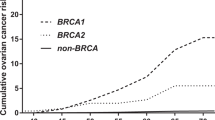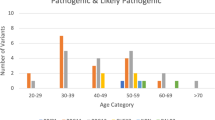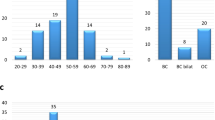Abstract
The breast cancer susceptibility gene BRCA2 on chromosome 13q12–13 has recently been identified1. Germline mutations of BRCA2 are predicted to account for approximately 35% of families with multiple case, early onset female breast cancer, and they are also associated with an increased risk of male breast cancer, ovarian cancer, prostate cancer and pancreatic cancer2–4. Germline mutations of a second cancer susceptibility gene BRCA1 (ref. 5), are associated with a strong predisposition to ovarian cancer as well as female breast cancer6. Recent studies have suggested that the phenotype in BRCA1 families with respect to the ratio of breast to ovarian cancer varies with the location of the BRCA1 mutation7,8. To determine whether germline mutations in BRCA2 are associated with a similar variation in phenotypic risk, we have analysed the distribution of mutations in 25 families with multiple cases of breast and/or ovarian cancer ascertained in the United Kingdom and Eire. These mutations all lead to premature truncation of BRCA2 as a result of frameshift deletions/insertions or nonsense mutations. Analysis of the mutation distribution along the length of the gene indicates a significant genotype-phenotype correlation. Truncating mutations in families with the highest risk of ovarian cancer relative to breast cancer are clustered in a region of approximately 3.3 kb in exon 11 (P = 0.0004). Published data on mutations in 45 other 0/?CA2-linked families provide support for this correlation.
This is a preview of subscription content, access via your institution
Access options
Subscribe to this journal
Receive 12 print issues and online access
$209.00 per year
only $17.42 per issue
Buy this article
- Purchase on Springer Link
- Instant access to full article PDF
Prices may be subject to local taxes which are calculated during checkout
Similar content being viewed by others
References
Wooster, R. et al. Identification of the breast-cancer susceptibility gene BRCA2. Nature 378, 789–792 (1995).
Wooster, R. et al. Localization of a breast cancer susceptibility gene, BRCA2, to chromosome 13q12-13. Science 265, 2088–2090 (1994).
Thorlacius, S. et al. A single BRCA2 mutation in male and female breast-cancer families from Iceland with varied cancer phenotypes. Nature Genet. 13, 117–119 (1996).
Phelan, C.M. et al. Mutation analysis of the BRCA2 gene in 49 site-specific breast-cancer families. Nature Genet. 13, 120–122 (1996).
Miki, Y. et al. A strong candidate for the breast and ovarian-cancer susceptibility gene BRCA1. Science 266, 66–71 (1994).
Easton, D.F., Bishop, D.T., Ford, D., Crockford, G.P. & the Breast Cancer Linkage Consortium. Genetic linkage analysis in familial breast and ovarian cancer. Am. J. Hum. Genet. 52, 718–722 (1993).
Gayther, S.A. et al. Germline mutations of the BRCA1 gene in breast and ovarian-cancer families provide evidence for a genotype-phenotype correlation. Nature Genet. 11, 428–433 (1995).
Holt, J.T. et al. Growth-retardation and tumor-inhibition by BRCA1. Nature Genet 12, 298–302(1996).
Gayther, S.A. et al. Rapid detection of regionally clustered germ-line BRCA1 mutations by multiplex heteroduplex analysis. Am. J. Hum. Genet. 58, 451–456 (1996).
Tavtigian, S.V. et al. The complete BRCA2 gene and mutations in chromosome 13q-linked kindreds. Nature Genet. 12, 333–337 (1996).
Mazoyer, S. et al. A polymorphic stop codon in BRCA2. Nature Genet. 14, 253–254 (1996).
Couch, F.J. et al. BRCA2 germline mutations in male breast-cancer cases and breast-cancer families. Nature Genet. 13, 123–125 (1996).
Neuhausen, S. et al. Recurrent BRCA2 6174delT mutations in Ashkenazi Jewish women affected by breast-cancer. Nature Genet. 13, 126–128 (1996).
Nagase, H. et al. Correlation between the location of germ-line mutations in the APC gene and the number of colorectal polyps in familial adenomatous polyposis patients. Cancer Res. 52, 4055–4057 (1992).
Gayther, S.A. et al. Regionally clustered APC mutations are associated with a severe phenotype and occur at a high frequency in new mutation cases of adenomatous polyposis coli. Hum. Mol. Genet. 3, 53–56 (1994).
Spirio, L. et al. Alleles of the APC gene: an attenuated form of familial polyposis. Cell 75, 951–957 (1993).
Author information
Authors and Affiliations
Rights and permissions
About this article
Cite this article
Gayther, S., Mangion, J., Russell, P. et al. Variation of risks of breast and ovarian cancer associated with different germline mutations of the BRCA2 gene. Nat Genet 15, 103–105 (1997). https://doi.org/10.1038/ng0197-103
Received:
Accepted:
Issue Date:
DOI: https://doi.org/10.1038/ng0197-103
This article is cited by
-
Correlation between the risk of ovarian cancer and BRCA recurrent pathogenic variants in Japan
Journal of Human Genetics (2022)
-
BRCA1 and BRCA2 pathogenic variants and prostate cancer risk: systematic review and meta-analysis
British Journal of Cancer (2022)
-
The landscape and driver potential of site-specific hotspots across cancer genomes
npj Genomic Medicine (2021)
-
Ancestry-specific predisposing germline variants in cancer
Genome Medicine (2020)
-
The association between cancer family history and ovarian cancer risk in BRCA1/2 mutation carriers: can it be explained by the mutation position?
European Journal of Human Genetics (2018)



